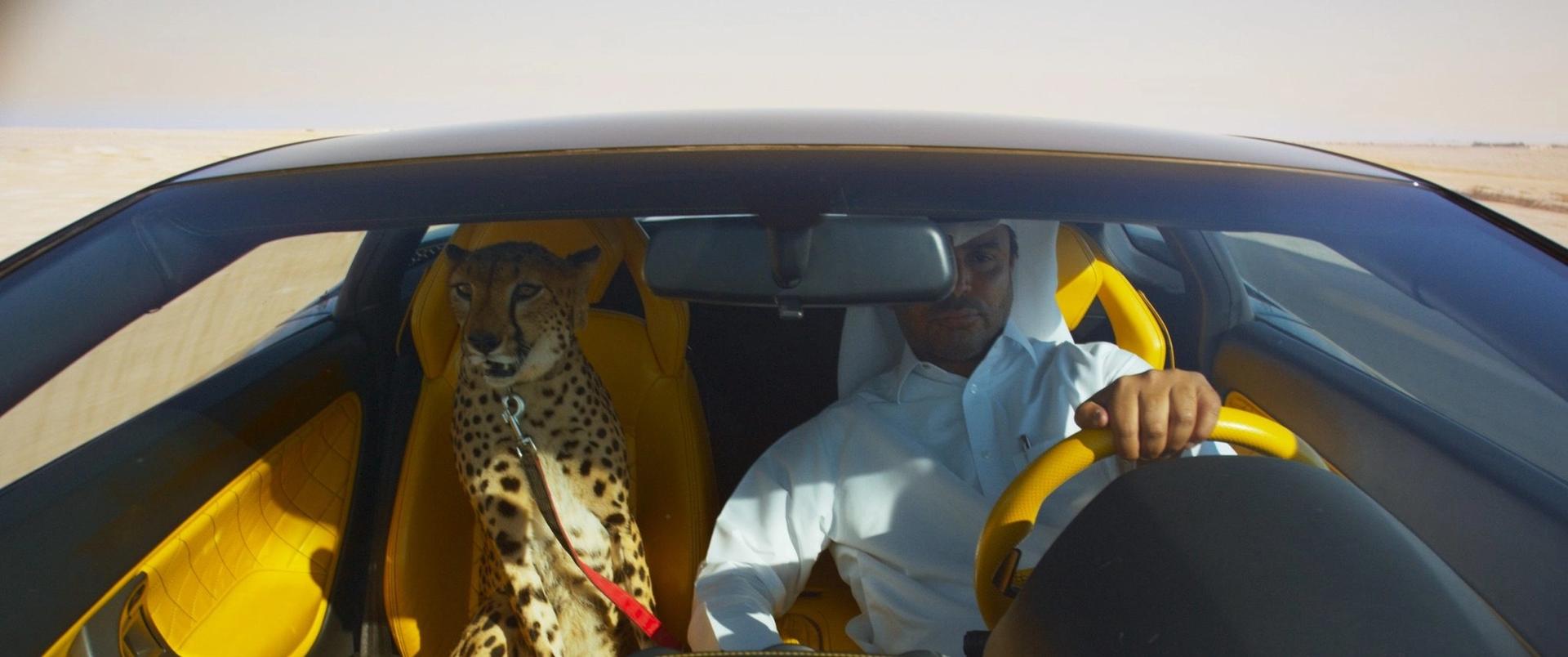Cheetah vs. Lambo: YURI ANCARANI’S Capitalist Mirage
“It has simply been genetically modified by capitalism,” Italian filmmaker Yuri Ancarani says of the Bedouin lifestyle captured in his art-documentary “The Challenge.” Moving through surreal zones of ultra-luxury in the Qatari desert, the film methodically follows a strange desert meet-up. Its subjects—some of whom Ancarani scouted on Instagram—include falconers, Cheetah-owners, and other speed enthusiasts. In one of Ancarani’s HD tableaus, a man tends to his falcons as they “fly” with him in his private jet. In another, a group of bikers dismount from their gold-plated Harley Davidsons and pray to Mecca. Through these highly exoticized images, “The Challenge” appears as a metonym for more universal realities about the global economy. While society inhales economic growth and democratic organization, it exhales opulence and extravagant waste. The first process is governed by rationality, the second by the libido and all of its desire-inflected machinations. While the “logic” of extravagance is normally shrouded behind hedges and tinted windows, in “The Challenge” it lies bare in the sands of the desert.
Thom Bettridge: In your statement on the film, you said that the characters you followed were citizens of modern metropolises reconnecting with a Bedouin tradition. I was wondering if you could elaborate on what you mean by that. What does the desert offer that the city does not?
Yuri Ancarani: “The Challenge” is a film about tradition. Wealth has transformed this territory, but it has not erased its memory. Falconry and a love for life in the desert are parts of these traditions. The grandfathers of many of the young men I met were once moving around the desert on a camel and with a tent. Not a lot of time has gone by. Everything is like it was before, it has simply been genetically modified by capitalism.
What drew you to this milieu of Qatari falconers and speed enthusiasts?
What interested me the most was Qatar, which is a really small country that until a few years ago was unknown. Now, it is one of the richest countries in the world. We hear people talking about Qatar everyday, but we are not aware of it. My fascination for the desert was what pushed me to get in contact with the contemporary Bedouin movement, and to understand and document their lives. I “met” Nasser — the gentleman who has the cheetah as a pet — on Instagram. I did everything to find him. I wanted him in the film!
Was spending time with these people similar to what you expected when you first saw them on the Internet?
There were a lot of situations that occurred rather unexpectedly — like the moment of prayer during the trip with the Harley Davidson riders, or the scene where the customized jeep tries to power up the dune without taking a run-up. Falconry is a very ancient practice tied to the tradition of the territory. Today, it was transformed into a crazy passion, similar to that of football for Italians. The event one sees at the end of the film is a race between the falcon and the pigeon. Its name was indeed “The Challenge.”
In your film, there are all of these little puns—or complex metaphors—between man-animal-machine. Like the scene with the private jet filled with falcons “flying.” Or the cheetah riding in the sports car. Why do you think our collective fascination with animal speed has remained, even though it has been outpaced by technology?
A film is an artwork that can be read from different perspectives and that opens you up to numerous reflections. What I search for with great effort is to show sublime images that relate to the present day. My goal is to search for contradictions and place them in conflict with one another, creating short circuits with the intent of having the viewer actively participate in a reflection.
The first films of yours that I saw was the trilogy “The Malady of Iron,” which has these beautiful examples of how the human body has been extended by machinery. This film seems to propose a similar but opposite constellation as that film did. Unlike machines, the animals in “The Challenge” have this element of danger and unpredictability. The man sitting on his sofa with his cheetah fears it will attack his friend. The men chasing a falcon in their SUV seem almost frantic. Is this element of chaos a type of masochism, or a rejection of the regularity of a technological life?
Your reflections are interesting. Different to the trilogy of the piece “The Malady of the Iron,” I believe that this film is on the theme of non-work. It is my first long film, an important step for the cinema world. But it is also a film where nothing happens. There are some missions and passions that never come to fruition. If you think about it, the only one who reaches its objective is the falcon, because it’s hungry. Here the animals are symbols, they are all sublime images.
I was really struck by this scene with the Qatari biker gang, because it seemed like a pure globalization of an Easy Rider mythology of the American West. Do you think the nomadic impulses of a bedouin lifestyle are something that exist outside of the Arabian peninsula?
Today’s ideal and symbolic city to emulate is not Paris, Rome, or Vienna, but Las Vegas. Las Vegas represents the dream. All the new metropolis are a copy of Las Vegas. If you like Venice, all you need to do is create a neighborhood or a hotel that looks like it. Las Vegas is the perfect city-symbol for capitalism. I believe that old Europe still sets the basis to follow another lifestyle, but I am not sure for how long that will continue.
